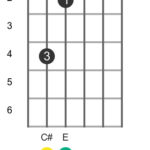For acoustic guitarists seeking to enhance their sound, multi-effects processors like the Line 6 Helix and HX Effects offer a world of possibilities. While primarily known for electric guitar, these pedals can significantly expand your acoustic palette. A key advantage of the Helix, often discussed among acoustic players, is its dedicated high impedance “Aux” input, a feature absent in the HX Effects. But does this, and other differences, make the Helix a clear winner for acoustic guitar, or can the HX Effects hold its own as an Acoustic Guitar Effects Pedal?
The Helix boasts an “Aux” input, designed to better accommodate the signals from some acoustic guitars, particularly those with passive pickups or specific preamp systems. This input can offer a more natural and less distorted sound compared to standard “Guitar” inputs when used with acoustics. While some Helix users find the regular “Guitar” input or even the return inputs perfectly acceptable, the “Aux” input is a distinct advantage for acoustic players seeking optimal signal integrity right from the start. Though the HX Effects lacks this specific input, it’s important to note that many acoustic guitarists successfully use the standard input or return inputs on various multi-effects units, including the HX Effects, with satisfying results.
Beyond input options, the Helix provides a broader ecosystem beneficial for acoustic performers. Its expanded I/O, including XLR outputs (missing on HX Effects), multiple effect loops, and microphone input capabilities, allows for more complex setups. Imagine seamlessly integrating vocal processing and direct XLR output to a PA system, all within the Helix. Furthermore, the Helix’s dual guitar inputs, including the Aux, cater perfectly to players switching between acoustic and electric guitars during performances. The inclusion of a built-in expression pedal adds real-time control over effects, and the substantial discount on Helix Native software sweetens the deal for studio integration.
However, dismissing the HX Effects as an acoustic guitar effects pedal would be premature. Its primary strengths are its lower cost and more compact footprint. For acoustic players primarily focused on core effects – reverb, chorus, delay, EQ – the HX Effects delivers these essentials effectively and affordably. While you sacrifice the expanded I/O, dedicated Aux input, and other advanced features of the Helix, the HX Effects remains a potent and portable solution for shaping your acoustic tone.
Ultimately, the choice between Helix and HX Effects as an acoustic guitar effects pedal hinges on your specific needs and priorities. If budget is a primary concern and your acoustic setup is relatively straightforward, the HX Effects offers excellent value and core functionality. However, if you demand maximum sonic fidelity from your acoustic, require extensive routing and I/O options, or desire seamless integration for both acoustic and electric guitars, the Helix, with its dedicated Aux input and expanded feature set, justifies its higher price and larger size as a superior, albeit more comprehensive, acoustic guitar effects pedal solution.

